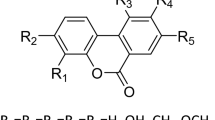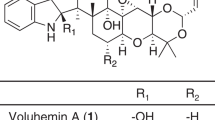Abstract
OF the three urobilinoid pigments excreted by man (i-urobilin, d-urobilin and stercobilin), only i-urobilin has a structure established by degradation and synthesis1. The structure of i-urobilin is as shown in (I), except that the end rings, in common with all so-called hydroxypyrroles, are probably lactam in nature2. The other two pigments are formally derived from i-urobilin by dehydrogenation and tetrahydrogenation respectively3.
This is a preview of subscription content, access via your institution
Access options
Subscribe to this journal
Receive 51 print issues and online access
$199.00 per year
only $3.90 per issue
Buy this article
- Purchase on Springer Link
- Instant access to full article PDF
Prices may be subject to local taxes which are calculated during checkout
Similar content being viewed by others
References
Siedel, W., and Meier, E., Hoppe-Seyl. Z., 242, 101 (1936).
Plieninger, H., and Decker, M., Liebigs Annalen, 598, 198 (1956).
Lowry, P. T., Ziegler, N. R., and Watson, C. J., Bull. Univ. Minn. Hosp. and Med. Found., 24, 166 (1952).
Linstead, R. P., J. Chem. Soc., 3728 (1954).
Fischer, H., and Halbach, H., Hoppe-Seyl. Z., 238, 59 (1936).
Pruckner, F., and Stern, A., Z. phys. Chem., 182A, 117 (1938).
Birch, A. J., Chem. and Indust., 652 (1955).
Siedel, W., and Grams, E., Hoppe-Seyl. Z., 267, 49 (1940).
Author information
Authors and Affiliations
Rights and permissions
About this article
Cite this article
GRAY, C., NICHOLSON, D. Structure of Stercobilin. Nature 179, 264–265 (1957). https://doi.org/10.1038/179264a0
Issue Date:
DOI: https://doi.org/10.1038/179264a0
This article is cited by
-
Electrophoretic Behaviour of i-Urobilin and Stercobilin
Nature (1958)
-
The IX-? Structure of the Common Bile Pigments
Nature (1958)
Comments
By submitting a comment you agree to abide by our Terms and Community Guidelines. If you find something abusive or that does not comply with our terms or guidelines please flag it as inappropriate.



